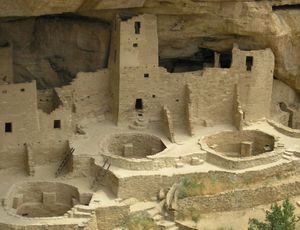
The results of the study conducted by researchers from the JU Institute of Archaeology in the canyons located in the border region between the US states of Colorado and Utah have been presented in the British journal Antiquity and made the cover of its latest issue. The article has been authored by Dr Radosław Palonka (head of the project, JU) and Katarzyna Ciomek, as well as Kathleen O’Meara and Zi Xu from the Maryland Institute College of Art, Baltimore.
Since 2011 the Jagiellonian University Institute of Archaeology has been running an archaeological project in Mesa Verde region located on the border of Colorado and Utah. The area is famous to both archaeologists and tourists for the Pre-Columbian Pueblo culture settlements built in rock niches or carved into canyon walls and for numerous ancient works of rock art. The research is the first Polish independent archaeological project in the United States and one of the few such European projects in the region.
The sites studied by the JU researchers contain remains of several dozen small settlements centred around Castle Rock Pueblo, built in the 13th century AD by Pueblo people. This was when the settlement were relocated from flat open areas to hard-to-access rock niches and shelters, such as the famous Cliff Palace, Spruce Tree House or Balcony House from Mesa Verde National Park in Colorado, or canyon rims and walls. Rock settlements, often surrounded by stone walls, were created, along with stone towers and underground tunnels linking selected buildings. They were most likely built for defensive purposes, which was related to the deteriorating environmental and climate conditions (including the beginning of the so-called Little Ice Age) as well as worsening conflicts and clashes, both within the Pueblo culture and against invaders from the outside (possibly members of hunter-gatherer tribes). As a results of these adverse social and environmental changes, which included environmental degradation caused by the Native Americans themselves, the entire border region between today’s Colorado and Utah became depopulated during the last two decades of the 13th century, and the Pueblo people migrated to the lands of modern Arizona and New Mexico.
 Within the framework of the Polish research project, the archaeologists managed to reconstruct the settlement system of the Pre-Columbian Pueblo culture in the canyons and analyse their defensive architecture. The system largely depended on effective communication between the particular stone towers and settlements. It seems to have been a perfectly functioning organism of allied settlements located in hard-to-access parts of the canyons, until the deteriorating environmental conditions along with the escalation of conflicts finally led to its downfall.
Within the framework of the Polish research project, the archaeologists managed to reconstruct the settlement system of the Pre-Columbian Pueblo culture in the canyons and analyse their defensive architecture. The system largely depended on effective communication between the particular stone towers and settlements. It seems to have been a perfectly functioning organism of allied settlements located in hard-to-access parts of the canyons, until the deteriorating environmental conditions along with the escalation of conflicts finally led to its downfall.
Besides the traditional archaeological methods the research including non-invasive methods involving modern technology, such as 3D laser scanning, photogrammetry, and state-of the art techniques of visualization of the obtained data. The cooperation with members of Hopi tribe from Arizona, who are the descendants of Pueblo people, turned out to be of great help in the interpretation of the findings. The results of the study shed a new light on the functioning of Pueblo culture in 13th century AD and the mysterious migration of its people, which has been one of the greatest unsolved archaeological mysteries in this field.





